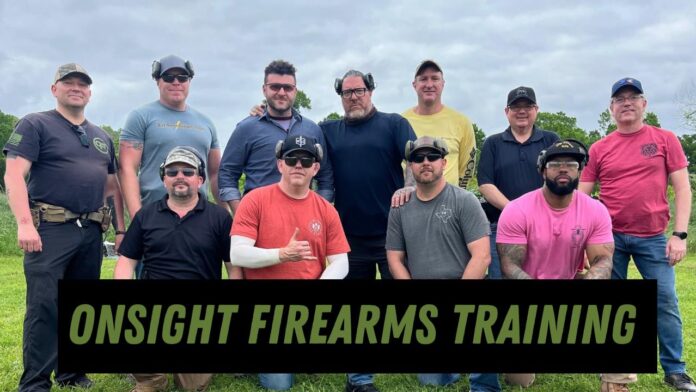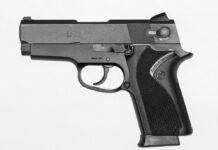
I’ll get the disclaimer out of the way up front: I’ve been connected with Ben DeWalt on Facebook for a while now, and we got a chance to meet in person at SHOT Show in Vegas back in January. During one of the after-hours informal networking gatherings, he graciously extended an invitation for me to attend Defensive Pistol when he came out to Houston in March. The invitation was not contingent upon a favorable review, but I do feel it important to mention that I did not pay for this class.
OnSight Firearms Training Defensive Pistol Course
The day started a little differently than most classes I’ve taken. After we went through introductions & the medical brief, we stepped up to the line, and Ben said, “I’m going to do something that no other instructor has done to you…I’m going to tell you the truth! You know why they always start shooting classes with a “warm-up exercise”? Is the instructor just being nice and letting you knock the rust off? No! This isn’t for you. It’s for me. This tells me where you are and how I’ll need to tailor the material & pace”
So, from the very first time our hands touched metal, there was already a little pressure due to expectation.
Ben likes shooting small targets, so we started the morning with a walk-back drill on a 3×5 card, followed by some discussions about trigger prep. Then, we advanced to some longer distances and then incorporated movement.
When I write course reviews, I don’t spend much time on the specific drills we run through. This is partially to keep people from trying to game their preparation and partially because all drills are working some combination of grip, sights, and trigger. It’s the diagnosis & individual feedback from the drills that matter most.
I always like touching on what the class IS & ISN’T, because that is what I feel best equips people to appropriately direct their training efforts.
WHAT IT IS:
Defensive Pistol is a principled-based, concealed carry-oriented class designed to develop and refine marksmanship and gun handling beyond the “stand and shoot” skills of intro-level courses. You’re not doing Hondo-rolls or fast-roping out of flaming helicopters. But you will learn what it feels like to draw and shoot while incorporating movement and what degree of ownership you truly have in your skill with a pistol.
WHAT IT ISN’T
This is not your “first class after your carry permit” type of course. While Ben & Rachel can certainly help someone with rudimentary skill, you’ll get the most out of this class if you already have good trigger & muzzle control, are comfortable working from a holster, and have a little more awareness & sensitivity about what’s going on during the shot cycle.
Years ago, I discovered The Short-Barreled Shepherd and his 3×3 Course Summary, which I have adopted for my reviews.
TOP 3 TOPICS COVERED:
- Methods for grip and trigger consistency. As you would imagine, as you start shooting from a less stable foundation, consistency in your grip and trigger press become even more important. Ben has his preferred method for gripping the pistol, and some specific touchpoints that help index his grip in the same place every time. I found this little hack particularly beneficial.
- Movement is a major focus of this course. Everything from “getting off the X” with lateral movement (more than just the single step often used to simulate movement) to advancing on & retreating from the target. Being able to read/control the wobble zone, as well as timing shots appropriately as the target zone grows or shrinks, is something that not enough people get exposure to outside of match conditions.
- Shot accountability and knowing your limitations. As we pushed out to longer distances and as movement got introduced, the emphasis was still on keeping hits in the -0 zone of the target. The emphasis was knowing what shots you could make and when you could no longer guarantee those hits (whether that be at a given distance or within a given timeframe).
TOP 3 TAKEAWAYS:
- I should be more deliberate on the trigger. Not slower, necessarily. Just trust my process instead of trying to make it happen within a given time window. It’s amazing how the difference in time between a good rep and one that “feels faster” is inconsequential.
- After taking Rangemaster Instructor Development last April, I’ve found that I vastly prefer a flagged/high thumbs grip over the conventional “thumbs forward” that was in vogue in the late aughts and early teens when I began my firearms training.
- It’s amazing that when I get out of my own head and trust that I know what I’m doing, I’m able to shoot pretty well. As soon as I try and make it happen, things fall apart.
3 THINGS I’LL BE DOING DIFFERENTLY:
- I’ve found that my action items from courses like this tend to be one or two little nuanced tweaks more than life-changing revelations anymore. What I walked away from with this class was a far better understanding of what my “right” trigger press feels like. So, I’ll be working on various exercises to groove that in more subconsciously.
I look forward to exploring more of OFT’s coursework. I like how Ben presents the material, and he offers a variety of material depending on what you’re looking for. If OnSight is coming to a range near you, I’d highly recommend signing up.



